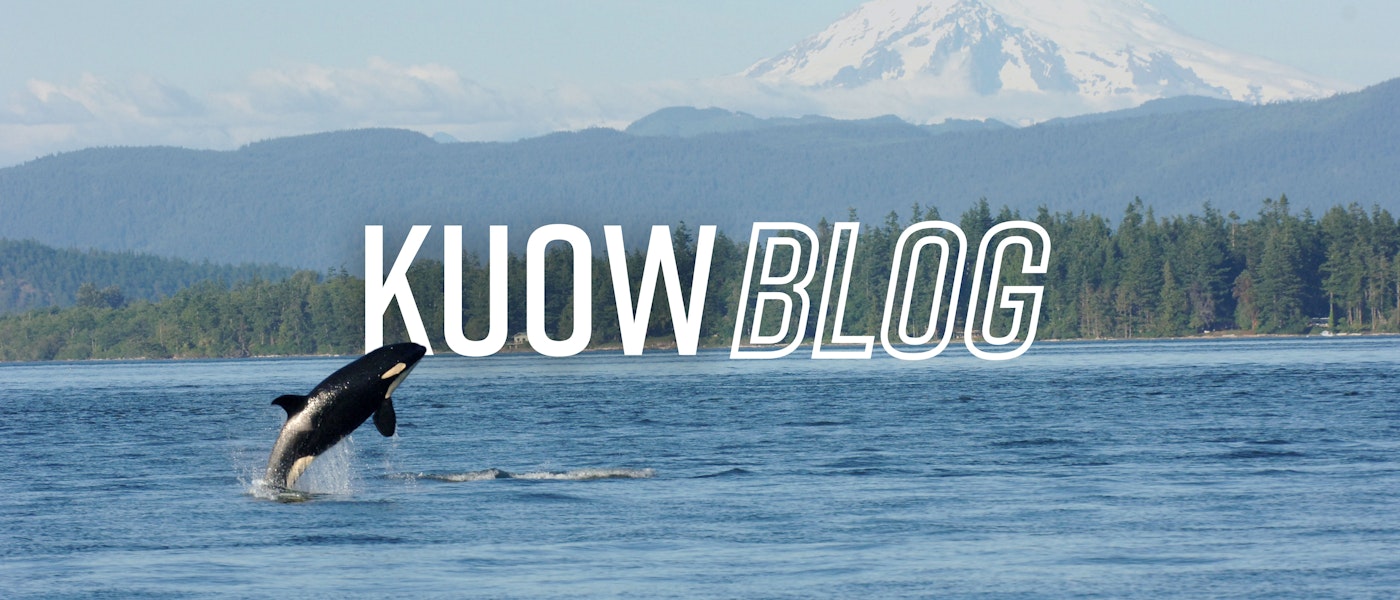

KUOW Blog
News, factoids, and insights from KUOW's newsroom. And maybe some peeks behind the scenes. Check back daily for updates.
Have any leads or feedback for the KUOW Blog? Contact Dyer Oxley at dyer@kuow.org.
Stories
-
‘That’s not nice!’ Brown bear eats entire family of ducks in front of kids at Seattle zoo
 Chick-eating grin: Juniper, a brown bear at the Woodland Park Zoo in Seattle who snarfed down a mama duck and her ducklings.Woodland Park Zoo
Chick-eating grin: Juniper, a brown bear at the Woodland Park Zoo in Seattle who snarfed down a mama duck and her ducklings.Woodland Park ZooJuniper is a 2-year-old brown bear at the Woodland Park Zoo, a large blonde girl described as sassy and mischievous by her keepers.
Last week, Juniper became TikTok famous for being, well, a bear. Here’s what happened.
It was a sunny day in Seattle, and Juniper had spotted a mama duck and her five fuzzy ducklings tootling along in her bear pond.
Juniper nimbly vaulted herself into the pond and swam straight for the ducks. She grabbed a duckling with her long claws, lifted it to her mouth and delicately bit its head off. Unsated, she went for another duckling, and then another, and finally, the mama.
The video was posted to TikTok four days ago by user Rachelle, who said she was at the zoo for her daughter’s birthday party. Children are heard screaming during the video – although not in horror.
“That’s not nice,” cried one, as Juniper slurped down a duckling like a raw oyster.
“That’s a good strategy,” said another enthusiastically, after Juniper separated the mama from her babies.
Others smacked the glass with their palms, presumably hoping to distract Juniper enough to save the ducks. But this brown bear did not care.
Midway through the slaughter, Rachelle, the parent recording the event, sounded resigned. “Hey buddy, can we not?" she said, in a tone typically reserved for children who have long ago broken their parents' spirits.
Juniper came to the Woodland Park Zoo in the summer of 2022 after being discovered alone on an airport runway in Anchorage, Alaska. Juniper, then 89 pounds, was a fluffy singleton who’d been separated from her mother. No one knows what happened to her mother, although it’s possible she was hit by a car or killed illegally.
Continue reading » -
Look, up in the sky! It's a drone ... painting over graffiti in Washington state
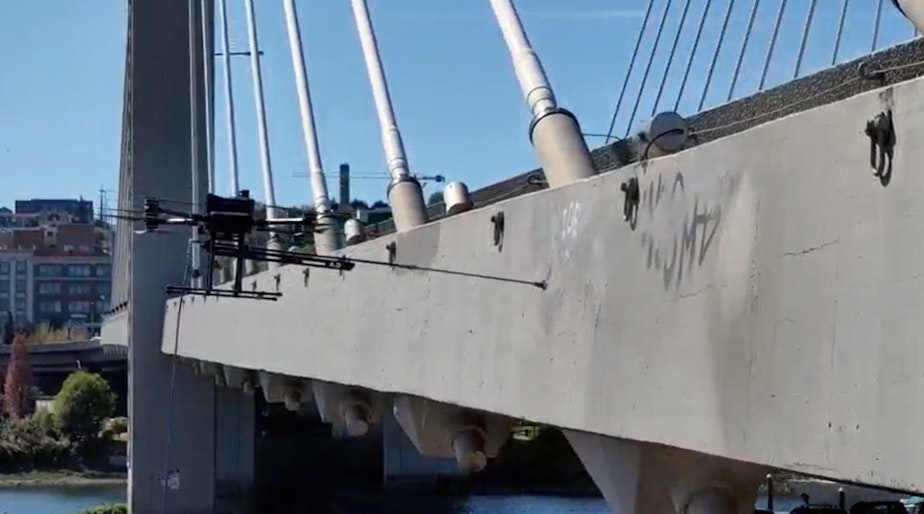 A drone equipped with spray paint covers over graffiti at a hard-to-reach spot along Tacoma's East 21st Street Bridge. WSDOT is experimenting with drones in limited areas in Tacoma and Olympia that can paint over graffiti.Washington State Department of Transportation
A drone equipped with spray paint covers over graffiti at a hard-to-reach spot along Tacoma's East 21st Street Bridge. WSDOT is experimenting with drones in limited areas in Tacoma and Olympia that can paint over graffiti.Washington State Department of TransportationThe Washington State Department of Transportation has begun experimenting with drones to take on graffiti along state roads. It's just one part of a larger experiment using cameras to tackle graffiti between Tacoma and Seattle.
"This is a pilot program to determine the benefits and challenges of using drone technology for graffiti removal, including whether it requires fewer staff to be working near active traffic and at high elevations requiring fall equipment," said WSDOT spokesperson Tina Werner.
RELATED: Pizza delivery via drone could soon be coming to Seattle and Tacoma
It's the first time a public agency has deployed drones to paint over graffiti, as far as WSDOT knows. The department is currently conducting a pilot that sends drones, equipped with a spray paint nozzle, to cover up graffiti in difficult spots, like bridges or very high up on walls. The drones have a hose that feeds paint to it from the ground. An operator (pilot) takes care of the rest.
The paint — called "DOT gray"— is water-based latex.
The drone-painting pilot is part of a larger effort approved by the state Legislature earlier this year. Lawmakers passed a bill aimed at mitigating graffiti, with two areas of focus. One is the drone pilot. The second is to "investigate and test improvements to systems capable of identifying persons who damage property with graffiti." According to WSDOT, $1 million was budgeted for this bill, a "small portion" of which is going toward the drone program. The remaining funds are being used to look into traffic camera tech that could monitor for graffiti removal.
RELATED: Seattle will start enforcing its anti-graffiti law again
"A large portion of the pilot program focuses on potential solutions for upgrading the state’s existing traffic camera infrastructure ... to determine if higher-resolution cameras, tracking software, and additional camera placements would enhance our ability to detect graffiti activity," Werner said, noting that WSDOT is in the "very early stages" of this program.
"WSDOT’s current cameras are designed and located to monitor traffic," she added. "If cameras were to be used for graffiti surveillance, the camera resolution and locations (additional focus on retaining walls, bridges, etc.) would need to be upgraded. Also, additional tracking software upgrades would be required as well as staff training."
Continue reading » -
Seattle Kraken fire head coach Dave Hakstol
 Seattle Kraken head coach Dave Hakstol looks on from the bench against the Colorado Avalanche during the third period of Game 4 of an NHL hockey Stanley Cup first-round playoff series Monday, April 24, 2023, in Seattle. The Seattle Kraken fired coach Dave Hakstol on Monday, April 29, 2024, after the third-year franchise took a significant step back following a playoff appearance in their second season.Lindsey Wasson / Associated Press
Seattle Kraken head coach Dave Hakstol looks on from the bench against the Colorado Avalanche during the third period of Game 4 of an NHL hockey Stanley Cup first-round playoff series Monday, April 24, 2023, in Seattle. The Seattle Kraken fired coach Dave Hakstol on Monday, April 29, 2024, after the third-year franchise took a significant step back following a playoff appearance in their second season.Lindsey Wasson / Associated PressOfficials with Seattle's Kraken hockey team announced Monday that they have let head coach Dave Hakstol go. A search for his replacement has already begun.
In a statement announcing that the team had "relieved" Hakstol, Kraken General Manager Ron Francis thanked the coach "for his hard work and dedication."
RELATED: NHL on the Eastside? New hockey arena discussed by Seattle Kraken and Kirkland
“Following our end-of-the-season review, we have decided to make a change at our head coach position," Francis said. "These decisions are never easy, but we feel this is a necessary step to help ensure our team continues to improve and evolve. Dave is a good coach and a terrific person. We wish him and his family all the best. We will begin our search for the Kraken’s next head coach immediately.”
Francis also wished assistant coach Paul McFarland and his family well, further announcing that McFarland is also out the door and will not return next season.
The NHL reported Francis expanded on why the organization fired its head coach at a press event Monday, saying that there had been "too many losing streaks" last season, so they want to try something new.
When Seattle got its NHL team in 2021, Hakstol came aboard as the first head coach of the hockey team. As the team parts ways with him, the Kraken noted the team had a 107-112-27 record under Hakstol's leadership. The team also went to the Stanley Cup playoffs in the 2022-23 season.
The NHL also reported the Kraken are keeping coaches Dave Lowry and Jay Leach, along with goaltending coach Steve Briere.
Continue reading » -
Washington’s border waters are on the cusp of a major rise in oil tanker traffic
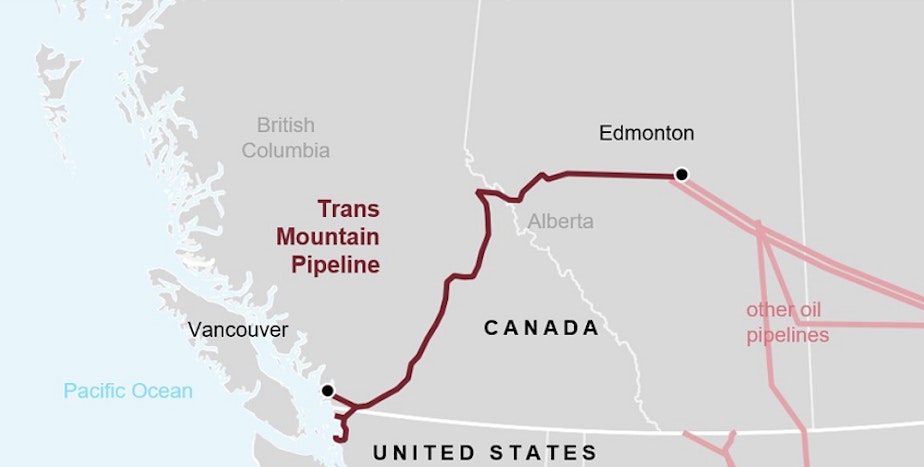 A map showing the Trans Mountain Pipeline that will fee crude oil to Vancouver, Canada, as well as to refineries across the border in Washington state.U.S. Energy Information Agency
A map showing the Trans Mountain Pipeline that will fee crude oil to Vancouver, Canada, as well as to refineries across the border in Washington state.U.S. Energy Information AgencyA significant increase in oil tanker traffic is in store for the Salish Sea with the completion of the Trans Mountain Pipeline expansion in British Columbia.
This story was first reported by the Washington State Standard. It is reprinted here under the community commons license.
In the link above, KUOW's Kim Malcolm talks to Tom Banse about his reporting.
The project triples the volume of Alberta crude the pipeline can carry to an export terminal in Burnaby near Vancouver, British Columbia. The facility now sends out an average of five loaded tankers per month. The expansion aims to raise the pace to one vessel per day. The oil-filled ships pass by the San Juan Islands and Olympic Peninsula as they head out to sea.
RELATED: Republicans, Democrats, carbon, and you. Debating Washington's cap and trade
Increased oil spill risks in shared waters, disturbances to endangered orcas and other whales and climate change impacts are among the worries the pipeline expansion has stoked across the border in Washington. The Canadian project inspired repeated protests from Puget Sound tribes, Gov. Jay Inslee and Attorney General Bob Ferguson. But they were all powerless to stop it.
Continue reading » -
University of Washington students join pro-Palestinian campus protest movement
University of Washington students have organized a pro-Palestine protest camp on the northeast side of the Seattle campus' Quad.
As of Monday morning, a couple dozen people were at the camp, speaking out against the Israel-Hamas war in Gaza. The camp is part of a growing movement at university campuses across the United States.
UW's Quad, normally quiet in the morning, was punctuated with student chants.
"Stop the war machine!" the protestors shouted. "Don't cry, we won’t let you die."
UW students protesting the war in Gaza are calling on the university to divest from Boeing, which organizers said has aided and profited from Israel's occupation in Gaza.
RELATED: Pro-Palestinian encampments and protests spread on college campuses across the U.S.
Continue reading » -
This carless Seattleite has a vision for the city's 'holistic' transportation future
 Anna Zivarts at the University of Washington light rail station. Her new book is "When Driving Is Not An Option."KUOW/Amy Radil
Anna Zivarts at the University of Washington light rail station. Her new book is "When Driving Is Not An Option."KUOW/Amy RadilWithout a car, people can find themselves walking on the shoulder of a road, steering their wheelchair out into traffic, and commuting longer and farther via transit.
Anna Zivarts wanted to highlight those experiences when it comes to transportation planning in a new book, titled "When Driving is Not an Option: Steering Away from Car Dependency."
Across Seattle, Zivarts can point to features that make travel easier and safer for people without a car – and places where they are sorely lacking.
RELATED: Seattle has a long road ahead to eliminate all traffic deaths by 2030
One of the better examples is the University of Washington light rail station, a hub for walking, biking ,and transit.
"In talking to folks who don't drive, living near light rail, that is sort of the dream, right?" Zivarts said. "Having this kind of access."
It does have its problems, though. Pedestrians must cross several lanes of traffic to reach their buses. And the cost of housing in some of these vibrant neighborhoods puts them out of reach for the people who most need that connectivity.
RELATED: How will your life change when Bellevue's light rail opens?
Meanwhile, other neighborhoods are more affordable but lack infrastructure for non-drivers. Zivarts said hundreds of housing units are about to come online farther south, at the intersection of Rainier Avenue South and I-90, where planning is underway for a new Judkins Park light rail station. But she said the area needs major safety upgrades for transit riders and pedestrians.
"Crossing Rainier and crossing the on-ramps, not very pleasant, super unsafe," she said. "Rather than this freeway-car funnel right there, how can this be a neighborhood?"
Through her work at Disability Rights Washington, Zivarts has tried to advocate for the estimated quarter of the population that doesn’t drive cars, due to age, income, disability, or other reasons.
RELATED: Is King County’s Flex commuter van a flop? We tested it out
Continue reading » -
Bellevue's light rail is rolling. Will a Seattle connection arrive in time for the World Cup?
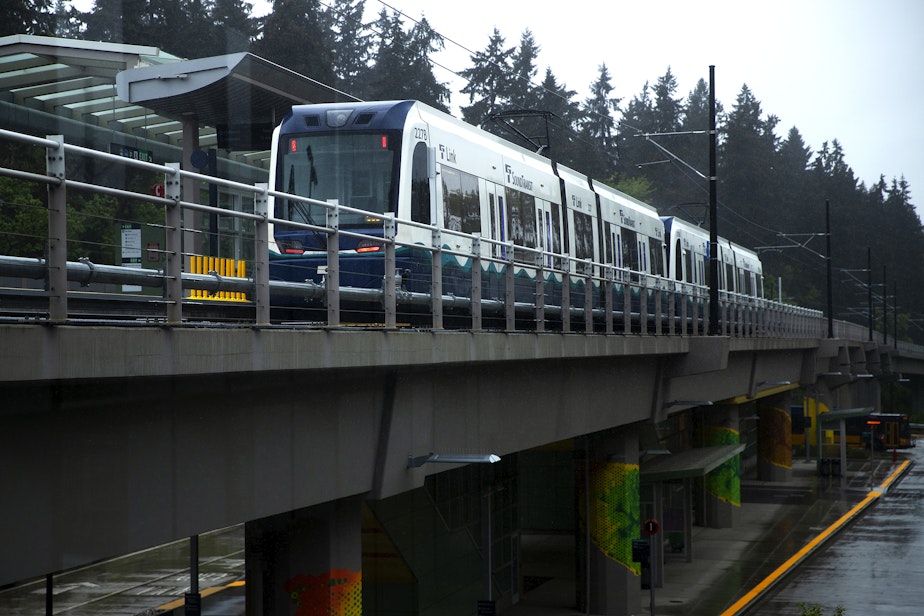 A Link light rail train arrives at South Bellevue Station on Thursday, April 25, 2024, in Bellevue. The new East Link Extension opens to the public on Saturday.KUOW Photo/Megan Farmer
A Link light rail train arrives at South Bellevue Station on Thursday, April 25, 2024, in Bellevue. The new East Link Extension opens to the public on Saturday.KUOW Photo/Megan FarmerAs Bellevue celebrates its first light rail line this weekend, regional leaders are celebrating, too, but perhaps for different reasons. Sure, opening up new transportation options on the Eastside is a big deal, but also, the new light rail line comes along ahead of a major deadline for the Seattle area — the World Cup in 2026.
“We have got to be ready for 2026," King County Councilmember Claudia Balducci told KUOW's Kim Malcom while standing in the newly opened South Bellevue station.
RELATED: How will your life change when Bellevue's light rail opens?
"Our goal is to open this entire line in 2025. But at the latest, we have to be ready for 2026. There are so many hotels in east King County that will be full of people coming from all over the world to see the World Cup. We need them to be able to use this amazing, fast, reliable transportation to get there and back. It'll just make that experience so much better."
Light rail opening in Bellevue is a milestone for the region. It's the first time this form of transportation has opened outside of the Seattle line that has been running for years. It will provide a major east-west connection between the region's most populous areas — communities that currently send considerable numbers of car commuters across two Lake Washington bridges. It also marks the first in a handful of new connections for the light rail system in a relatively short period of time.
There is a range of new light rail access coming online in the next couple of years. Trains will start running up to Lynnwood in August 2024, extending rail beyond Seattle's Northgate station. Light rail down to Federal Way is expected in 2026.
RELATED: After 16 years and $3 billion, Lynnwood light rail set to open this summer
"After this opening, the next one will be to Lynwood, and then to Federal Way," Balducci said. "And I would be excited if I were them because it will be here before you know it."
The extension to Federal Way will add 7.8 miles of rail south of Seattle, and will also activate stations in Kent and Des Moines. The three new stations will have parking to accommodate 3,200 vehicles.
Bellevue's light rail line was originally intended to connect to Seattle, across the floating I-90 bridge. That would connect Bellevue to Mercer Island, and Judkins Park in Seattle. But that portion of the line has been plagued by construction mishaps and delays. Balducci, who sits on the Sound Transit Board's expansion committee, said that they have decided to stay with the current construction contractor to get the job done sooner than later. After that, "we are going to have to work through who's responsible for the workmanship problems, and who pays for which aspects. That will all have to be worked out in a negotiation or ultimately in court."
Continue reading » -
Everett reports 3 fentanyl overdoses in young children in 1 week
 The Drug Enforcement Administration issued a warning in August 2022 that "rainbow fentanyl" had been seized in 26 states. The DEA said it appeared to be a deliberate attempt by traffickers to make the drugs attractive to youth.
The Drug Enforcement Administration issued a warning in August 2022 that "rainbow fentanyl" had been seized in 26 states. The DEA said it appeared to be a deliberate attempt by traffickers to make the drugs attractive to youth.The Everett Fire Department said in a statement Thursday that this week the city’s firefighters have responded to three suspected fentanyl overdoses in very young children, one of them fatal.
“The City of Everett is deeply concerned about the increasing fentanyl overdoses that involve young children," the statement reads. "Even a small amount of fentanyl residue can be lethal to children, as the drug can be more potent to a baby or toddler's smaller body and lack of opioid tolerance. Pills can look like candy to children, especially when they're brightly colored.”
Firefighters were able to revive two children, aged 6 and 11 months, with the overdose reversal medication Narcan, but a third child, aged 13 months, died.
“The Snohomish County Medical Examiner's Office will conduct a positive identification of the child, as well as determine the official cause and manner of death,” the statement said.
RELATED: Report: China continues to subsidize deadly fentanyl exports
Dr. James Lewis, the health officer for Snohomish County, called the three incidents “a complete tragedy” and said he’s scrutinizing the available data “trying to think of ways we can work to prevent this from happening in the future.” Snohomish County reports opioid overdose deaths on a dashboard.
Lewis said deaths among children aged 15 and under remain extremely rare.
The county had no such deaths in 2020 or 2021. But in 2022 there were four, and two more so far this year before the Everett Fire Department’s announcement.
Lewis said nonfatal overdoses in young children are also a growing concern.
“We do hear from partners that there is increasing nonfatal overdoses as well, which can obviously be very traumatic and scary both for the infant and for the family,” he said.
RELATED: Curriculum about fentanyl, other opioids could come to WA junior high classrooms
Continue reading » -
Stranded baby orca swims free after being trapped in a BC lagoon for 5 weeks
 Two-year-old T1093A, also known as "brave little hunter" was stuck for five weeks in a lagoon on the Northwest Coast of Vancouver, Canada. The baby orca finally swam back out to sea Friday.
Two-year-old T1093A, also known as "brave little hunter" was stuck for five weeks in a lagoon on the Northwest Coast of Vancouver, Canada. The baby orca finally swam back out to sea Friday.The baby orca known as Brave Little Hunter is swimming free after spending weeks trapped in a lagoon off of Vancouver Island. But work is not finished to ensure the wellbeing of the calf.
Fisheries and Oceans Canada reports that Brave Little Hunter — aka kʷiisaḥiʔis — was able to swim out of the lagoon early Friday morning.
RELATED: Why are these killer whales increasingly showing up in the Salish Sea?
"Five weeks ... there's been a lot of ups and downs, twists and turns, given the death of mom, and figuring out the best way to approach the situation, and recognizing that the animal was likely nutritionally impacted," said Paul Cottrell with Fisheries and Oceans Canada at a press event Friday afternoon.
In late March, the calf became trapped in the lagoon with its mother, known as T109A3. The pair swam into the lagoon during high tide and became stuck when the water retreated. The mother did not survive as the water levels declined. The calf, however, has remained in the lagoon ever since and officials with Fisheries and Oceans Canada, along with members of the Nuchatlaht First Nation and Ehattesaht First Nation, have attempted to rescue it.
An attempt to get the calf out of the water and onto a truck failed on April 12.
On April 25, during a high tide, a rescue crew with members of the Nuchatlaht First Nation and Ehattesaht First Nation used an inflatable vessel and sea lion meat to coax the calf out of the lagoon. It took time, but it worked.
"Yesterday, with moving the calf to the causeway, so close to getting her (out of the lagoon), unfortunately she didn't (leave) and it was a low tide," Cottrell said, noting they watched the calf overnight. "Then at about 2:30 a.m. ... we actually saw her disappear and we believe that she went through. We confirmed that this morning."
In the early morning hours of April 26, Brave Little Hunter made her way out of the lagoon entirely. She was soon spotted swimming in the Espinosa Inlet, heading toward the Esperanza Inlet.
RELATED: Orcas are actually not one species, but three
The mission now is to reunite Brave Little Hunter with her extended orca family. Rescue crews are working to encourage the calf to swim toward more open water, however, it is not exactly known where she is. Crews are monitoring the location of other Bigg's killer whales in the region.
Continue reading » -
Counting down to ‘All Aboard!’ East Link: And it still has that new (light rail) car smell
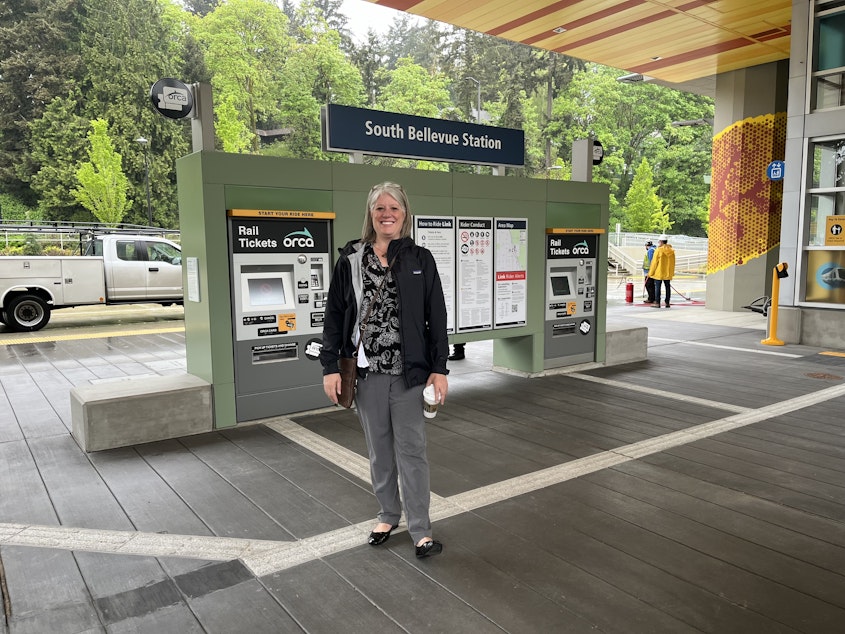 King County Councilmember Claudia Balducci at the South Bellevue Station, a new light rail station that opened April 19, 2024.Kim Malcolm ? KUOW
King County Councilmember Claudia Balducci at the South Bellevue Station, a new light rail station that opened April 19, 2024.Kim Malcolm ? KUOWIt's been years in the making and finally, light rail is officially opening in Bellevue Saturday. KUOW’s Kim Malcolm went to the South Bellevue Station to get a closer look and talk to King County Councilmember Claudia Balducci, who championed the project on the Eastside.
This interview has been edited for clarity.
Kim Malcolm: The East Link extension was supposed to cross Lake Washington into Seattle. That's not where we're at right now. So why is opening just this section still a big deal?
Claudia Balducci: We will ultimately connect to Seattle. But there's been some rework needed on the I-90 bridge segments. That left this entire Eastside segment of eight stations over six and a half miles completed, ready to go, but unable to connect yet to (Seattle). It was really important to me that we put it to use.
The voters are investing in this system, it's ready to go. There are a lot of reasons people would travel this segment. There are big employment centers and activity centers, and frankly, it's better for Sound Transit. Mothballing stations for a year without use would be more expensive and more difficult than putting them to use for the public. So, this just made sense.
What have you been hearing from East-siders about the opening of this line?
When I first came out and said we should open the stations that are ready to go, it was the most popular thing I have ever proposed. People love the idea they are ready to ride. They've been waiting a long time, and it's very exciting for folks to come and ride it. I see smiles on people's faces, and they haven't even gotten on board yet.
Traffic is an issue everywhere. Talk a little bit about commuting, and what you think is going to happen here.
I've had a chance to ride it, and the thing you notice when you get on is it goes very smoothly and very quickly through a relatively congested part of the region. There's no way you could get from here to there as quickly by any other means, not by car, not on the freeway. This is the fastest way to get between these points.
The connection over the I-90 bridge has been pushed back for at least another year for a variety of reasons. Is there going to be accountability for that delay?
Yes. I'm a chair of the Sound Transit Board System Expansion Committee, which oversees our capital projects. We decided to stay with the current contractor to complete the bridge. That was the best, fastest, most reliable way to actually get the project done, in our view. When it's over, we are going to have to work through who's responsible for the workmanship problems, and who pays for which aspects. That will all have to be worked out in a negotiation or ultimately in court.
Continue reading » -
Seattle cop accuses Chief Diaz of ‘predatory behavior’ and ‘grooming’
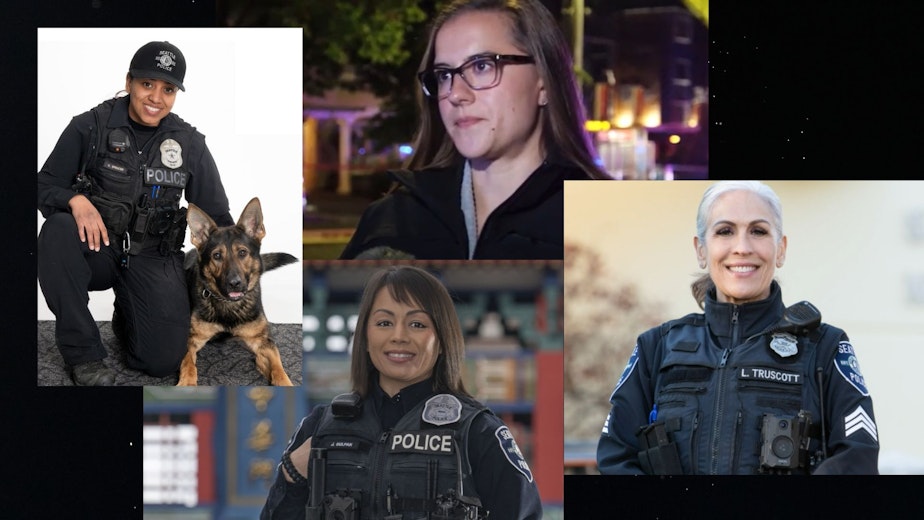 Four women police officers filed a tort with the City of Seattle on Thursday, alleging sex discrimination and harassment. Counterclockwise from left, Officer Kame Spencer, Officer Valerie Carson, Lt. Lauren Truscott, and Officer Jean Gulpan.Seattle Police Department
Four women police officers filed a tort with the City of Seattle on Thursday, alleging sex discrimination and harassment. Counterclockwise from left, Officer Kame Spencer, Officer Valerie Carson, Lt. Lauren Truscott, and Officer Jean Gulpan.Seattle Police DepartmentThis story was updated to include a statement from Chief Adrian Diaz's personal attorney.
Four female Seattle police officers notified the city on Thursday that they intend to sue for sex discrimination, harassment, and hostile work environment.
The four women are Lt. Lauren Truscott, Officer Valerie Carson, Officer Kame Spencer, and Officer Judinna (Jean) Gulpan. They’re asking for $5 million in damages.
Allegations of harassment extend to the chief. “Chief [Adrian] Diaz seemingly engaged in predatory and discriminatory behavior,” wrote Sumeer Singla, attorney for the four women. Singla is a former assistant city attorney for Seattle, and provided counsel to the police department.
RELATED: 10 female cops speak out about sexism, harassment within the Seattle Police Department
Specifically, Diaz appeared to show interest in Officer Valerie Carson, Singla wrote, beckoning her for long chats at the end of her work shift in public affairs. “Chief Diaz’s practice became a running joke amongst his security detail, because they could not leave either.”
Diaz also commented on Carson’s dresses and high heels, according to the tort, and asked her to drive alone with him on New Year’s Eve 2020. Carson, uncomfortable, asked that his security detail be present.
“Ms. Carson thought it was odd that the SPD chief would want to go out alone with a female patrol officer on one of the busiest and hectic nights in the city without a security detail,” the tort reads. After some persistence, Diaz agreed to bring his detail, the tort says.
The chief also offered to do handy work at Carson’s house. She declined.
Continue reading » -
Seattle's street trees have something to tell you
Taha Ebrahimi pointed to a golden chain tree along a street in Seattle's Georgetown neighborhood. It's the widest of its kind in the entire city. But golden chain trees have slowly disappeared from Seattle over the decades.
“These seeds ... these are actually poisonous," Ebrahimi told KUOW's Paige Browning on an episode of Seattle Now.
RELATED: Seattle passed a tree protection law last year. So why did a 'protected' cedar get the ax?
"In the 1960s, Seattle Children’s Hospital considered golden chain to be the biggest threat to children in Seattle. And now there are only 338 golden chain street trees in the city, probably for that reason.”
Golden chain trees have bright yellow flowers that droop when they bloom. They're among a wide variety of street trees in Seattle — trees planted along sidewalks or at least 10 feet from a curb. They're one of the reasons Seattle is so green. But such trees are more than decoration. Aside from the shade and noise damping benefits they provide, trees tell stories. They hold history. It's a history Ebrahimi says anyone can find sprouting throughout the city.
Street trees of Seattle
Like many did when the pandemic hit in 2020, Ebrahimi started taking neighborhood walks. She’d pass one tree, then another, very different varieties, and started wondering how, and why, they were there.
Luckily, Seattle has an online tree database for such curious minds. It helped, but it has its limits. So Ebrahimi called up Arthur Jacobson, author of “Trees of Seattle” and got him to join her on what became street tree walks.
“Together, we’d be walking and validating this data and it became obvious that a lot of the data was wrong," Ebrahimi said. "We found out about 22% of the city’s data was wrong.”
That put Ebrahimi on a mission: To accurately track Seattle’s street trees. It also added up to her new book, “Street Trees of Seattle.”
Continue reading »
